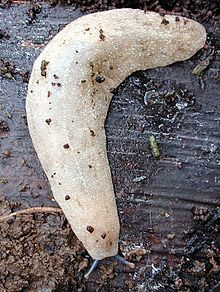Veronicella sloanei
| Veronicella sloanii | |
|---|---|
 |
|
| A live individual of Veronicella sloanii, head end towards the bottom of the image | |
| Scientific classification | |
| Kingdom: | Animalia |
| Phylum: | Mollusca |
| Class: | Gastropoda |
| (unranked): |
clade Heterobranchia clade Euthyneura |
| Superfamily: | Veronicelloidea |
| Family: | Veronicellidae |
| Genus: | Veronicella |
| Species: | V. sloanii |
| Binomial name | |
|
Veronicella sloanii (Cuvier, 1817) |
|
| Synonyms | |
|
|
clade Euthyneura
clade Panpulmonata
clade Eupulmonata
clade Systellommatophora
Veronicella sloanii,commonly called the Pancake Slug, is a species of air-breathing land slug, a terrestrial, pulmonate gastropod mollusk in the family Veronicellidae, the leatherleaf slugs.
When extended, this slug can attain a length of 12 cm (5 in.). It is highly variable in coloration and positive identification depends on dissection and inspection of the genitalia. It is usually very pale in color, ranging from mottle pale yellow, cream to white. It may have irregular black spotting or speckling all over the dorsal surface that may coalesce into two poorly defined bands running down either side of the body; in the juveniles, these two bands may be clearer and better defined as grey bands, especially anteriorly. Occasionally the snail can be mostly brownish. The only constant color character among different Caribbean island populations is the eye stalk, which is bluish grey with a light brown tip.
The indigenous distribution of Veronicella sloanii is Jamaica. The type locality is in Jamaica.
Other non-indigenous distribution includes:
This slug has been introduced to Florida and it has become an agricultural pest there.
Controversially Cowie et al. (2009) considered this species has not yet become established in the USA, but it is considered to represent a potentially serious threat as a pest, an invasive species which could negatively affect agriculture, natural ecosystems, human health or commerce. Therefore it has been suggested that this species be given top national quarantine significance in the USA.
...
Wikipedia
